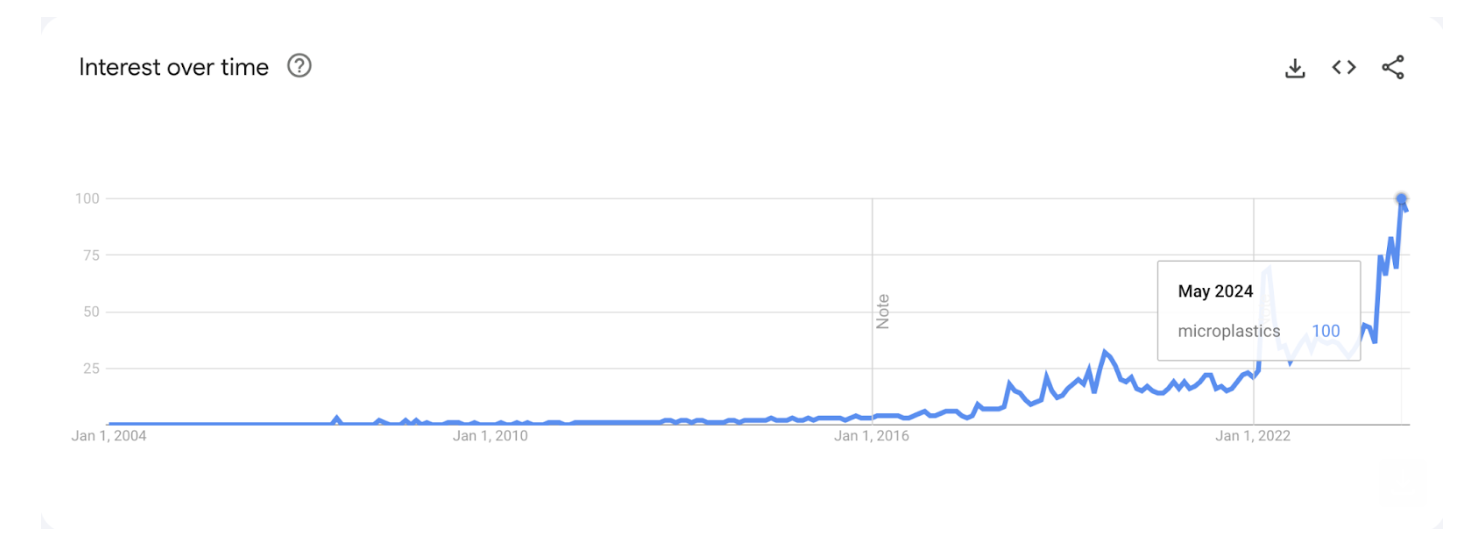Comments
- No comments found

The recent discovery of microplastics in human testicles has sent shockwaves across the globe.
This has lead to a significant increase in Google searches related to the topic. People are eager to understand the potential implications of this finding on male reproductive health and fertility.
As news broke at the end of May of microplastics being found in every human testicle tested, worldwide searches for ‘microplastics’ hit a new record Google Trends score of 100 for the first time ever according to new research from CleanHub.

(Microplastic searches over the last 12 months)
Highlighting the growing concern around microplastics, searches on them have become increasingly higher over the last few years, especially after the release of studies showing record numbers found in plastic bottles and linking them to raised risk of heart attacks and strokes earlier this year.
However, the recent study from the University of New Mexico has driven the most widespread search interest over microplastics around the globe. Many are also searching for information on how microplastics enter the body and how they can be lessened or removed.

(Microplastic searches since 2004)
The top related breakout searches include ‘microplastics testicles’, ‘microplastics found in semen’, as well as ‘how microplastics enter your body’’, ‘how to remove microplastics from your body’ and ‘can you filter microplastics out of water’ (yes, you can).
The news from last week showing microplastics being found in penises is also increasing searches of this nature - ‘microplastics in penises’ search interest has shot up by 3550%.
Nikki Stones, Vice President of Marketing at CleanHub, comments:
“The findings of this latest study have clearly resonated with many people who are understandably worried for their health, and that of their children. This should be used as a turning point on plastic use and recycling.
There is no clearer sign that better plastic recycling and reuse, as well as an overall decrease in production, must be implemented to combat microplastics.”
CleanHub has also created a new guide highlighting 7 everyday items that should be avoided due to the microplastics they release, with alternative solutions included. These are:
1. Plastic cutting boards - exposing humans to up to 79.4 million polypropylene microplastics each year.
Alternative: Tempered glass or paper fibre chopping boards.
2. Microwavable food containers - up to 4 million microplastics released in every square centimeter of some plastic packaging.
Alternative: Ceramic or glass containers.
3. Ice cubes (pre-packaged and plastic ice cube trays) - 100% of tested pre-packaged ice cubes contain microplastic contamination, as does freezing plastic trays. Alternative: Stainless steel or silicone ice cube trays.
4. Paper cups - While paper cups may seem better for the environment, paper cups need a layer of sealant to hold liquids inside, which often consist of up to 10% high-density polyethylene (HDPE).
Alternative: reusable stainless steel flasks or bottles.
5. Tea bags - scientists found last year that one cup of tea contained up to 3.1 billion nanoplastics due to the tea bag.
Alternative: loose tea leaves in a cast-iron teapot or a metal strainer. Cotton tea bags or straining your drinking through organic linen.
6. Synthetic makeup - just 13% of the 7,000 beauty products they analyzed were free from microplastics.
Alternative: cosmetics with natural ingredients and plastic-free packaging, brands that offer glass refill programs and look for ethically sourced and natural ingredients, like plant extracts.
7. Polyester clothing - almost 33% of dust found within a typical home consists of microplastics derived from textiles, and a single load of polyester clothing laundry can release up to 1.5 million synthetic microfibers into waterways.
Alternative: natural fiber clothing made from cotton or hemp.
Leave your comments
Post comment as a guest